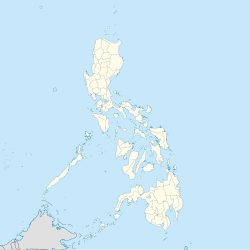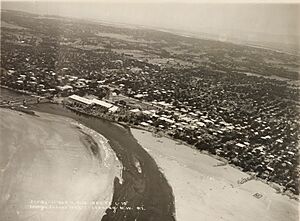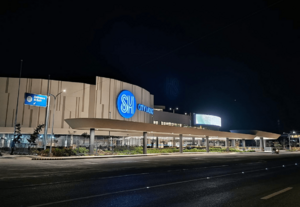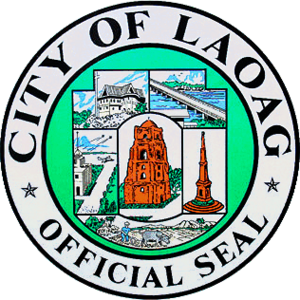Laoag facts for kids
Quick facts for kids
Laoag
|
|||
|---|---|---|---|
|
Component city
|
|||
|
From top, left to right: Ilocos Norte Provincial Capitol, Exterior of Laoag International Airport, La Paz Sand Dunes, Laoag Cathedral, Sinking bell tower of Laoag
|
|||
|
|||
| Etymology: Ilocano: lawag ("light") | |||
| Nickname(s):
The Sunshine City
|
|||
| Anthem: Marcha de Laoag (Laoag March) | |||
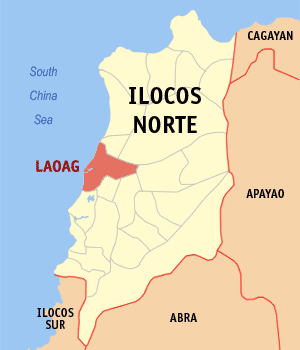
Map of Ilocos Norte with Laoag highlighted
|
|||
|
OpenStreetMap
|
|||
| Country | |||
| Region | Ilocos Region | ||
| Province | Ilocos Norte | ||
| District | [[{{#property:P7938}} | — Lua error in Module:Wd at line 1804: attempt to index field 'wikibase' (a nil value).]] | ||
| Founded | 1580 | ||
| Cityhood | June 19, 1965 | ||
| Barangays | 80 (see Barangays) | ||
| Government
|
|||
| • Type | Sangguniang Panlungsod | ||
| Area | |||
| • Total | 116.08 km2 (44.82 sq mi) | ||
| Elevation | 57 m (187 ft) | ||
| Highest elevation | 759 m (2,490 ft) | ||
| Lowest elevation | 0 m (0 ft) | ||
| Population
(2020 census)
|
|||
| • Total | 111,651 | ||
| • Density | 961.85/km2 (2,491.17/sq mi) | ||
| • Households | 27,875 | ||
| Economy | |||
| • Income class | 3rd city income class | ||
| • Poverty incidence |
|
||
| • Revenue | ₱ 1,134 million (2022) | ||
| • Assets | ₱ 20,971 million (2022) | ||
| • Expenditure | ₱ 734.3 million (2022) | ||
| • Liabilities | ₱ 640.3 million (2022) | ||
| Service provider | |||
| • Electricity | Ilocos Norte Electric Cooperative (INEC) | ||
| Time zone | UTC+8 (PST) | ||
| ZIP code |
2900
|
||
| PSGC |
[https://psa.gov.ph/classification/psgc/?q=psgc/barangays/{{#pro000®code={{&provcode=
|
||
| IDD : area code | +63 (0)77 | ||
| Native languages | Ilocano Tagalog |
||
| Website | www |
||
Laoag is a city in the Philippines. It is the capital of the province of Ilocos Norte. The name "Laoag" comes from the Ilocano word lawag, which means "light."
Laoag is the biggest city in its province. It is also the main center for business and industry. The Laoag International Airport, the busiest airport in the Ilocos Region, is located here. Laoag is the northernmost city in the Philippines.
The city is surrounded by other towns like San Nicolas, Paoay, Sarrat, Piddig, Vintar, and Bacarra. To the east are the Cordillera Central mountains, and to the west is the South China Sea.
Laoag has a monsoon climate. This means it has a dry season from November to April and a wet season from May to October. Even though strong typhoons sometimes hit the city, it is still known as the "Sunshine City."
History of Laoag City
Long ago, even before the Spanish arrived, the area where Laoag is now was rich in gold. Traders from Japan and China came to trade gold for items like beads, ceramics, and silk. The local people, called Austronesians, called their land samtoy, meaning "this is our language."
Spanish Arrival and Naming
In 1571, after taking control of Manila, Spanish explorers looked for new lands. Juan de Salcedo, a young explorer, led a group north. On June 13, 1572, Salcedo and his men landed in Vigan. They then traveled to Laoag and other nearby places. As they sailed, they saw many sheltered bays, which they called looc. This led them to name the region "Ylocos" and its people "Ylocanos."
Building Churches and Towns
As more people became Christian, the Spanish built many churches and bell towers. This was part of their plan to gather people "under the bells" (bajo de las campanas). This meant people lived close to the church and its bells. Garrisons, or military posts, were often found near the church bells in the town square. This helped the Spanish control the area.
Local Uprisings and Independence Movements
The Spanish rule was not always peaceful. Many locals, called Ilocanos, fought against the Spanish because of unfair practices by some priests.
- In 1589, the Dingras uprising happened.
- In 1660, Pedro Almasan led a revolt in San Nicolas.
- From 1762 to 1763, Diego Silang led battles to free the Ilocanos. After he was killed, his wife, Gabriela, continued the fight but was also captured.
- In 1807, people in Piddig protested against the government's control over the wine industry. This was known as the Basi Revolt.
- In 1898, Gregorio Aglipay was removed from the church for supporting Filipino revolutionaries. He then started the Iglesia Filipina Independiente, a Filipino church. This movement helped Filipinos regain their pride.
The population grew a lot between 1715 and 1818. This made it hard to manage the province. Because of many uprisings and forced labor, the Ilocos province was divided into two. On February 2, 1818, a Spanish Royal Decree officially split Ilocos into Ilocos Norte and Ilocos Sur. Laoag, being the largest town, became the capital of Ilocos Norte.
World War II and Cityhood
The Japanese Army took over Laoag on December 12, 1941, during World War II. They used its airport for most of the war.
Laoag officially became a city on June 19, 1965. This happened after a public vote and a law passed by Senate President Ferdinand Edralin Marcos. Laoag remained the capital of Ilocos Norte. Mayor Eulalio F. Siazon and Engineer Trinidad Lucas Aurelio were key people who worked to make Laoag a city. Simeon M. Valdez and Antonio V. Raquiza also helped by filing the bill in Congress. Eulalio Fonacier Siazon became the first city mayor.
Geography of Laoag
The City of Laoag is in the west-central part of Ilocos Norte. It is next to the South China Sea. To its east is Sarrat, to the southeast is San Nicolas, and to the southwest is Paoay. To the northeast is Vintar, and to the northwest is Bacarra. Laoag is one of the largest cities in the Ilocos Region.
Laoag is about 483 kilometers (300 miles) away from Manila, the capital city of the Philippines.
Barangays in Laoag
Laoag is divided into 80 smaller areas called barangays. Each barangay has smaller parts called puroks and some have sitios.
| Conventional Long Name | Barangay Number |
Name | Former Name/Territory |
|---|---|---|---|
| Barangay No. 1, San Lorenzo (Poblacion) | 1 | San Lorenzo | Poblacion |
| Barangay No. 2, Santa Joaquina (Poblacion) | 2 | Santa Joaquina | Poblacion |
| Barangay No. 3, Nuestra Señora del Rosario (Poblacion) | 3 | Nuestra Señora del Rosario | Poblacion |
| Barangay No. 4, San Guillermo (Poblacion) | 4 | San Guillermo | Poblacion |
| Barangay No. 5, San Pedro (Poblacion) | 5 | San Pedro | Poblacion |
| Barangay No. 6, San Agustin (Poblacion) | 6 | San Agustin | Poblacion |
| Barangay No. 7-A, Nuestra Señora del Natividad (Poblacion) | 7-A | Nuestra Señora del Natividad | Poblacion |
| Barangay No. 7-B, Nuestra Señora del Natividad (Poblacion) | 7-B | Nuestra Señora del Natividad | Poblacion |
| Barangay No. 8, San Vicente (Poblacion) | 8 | San Vicente | Poblacion |
| Barangay No. 9, Santa Angela (Poblacion) | 9 | Santa Angela | Poblacion |
| Barangay No. 10, San Jose (Poblacion) | 10 | San Jose | Poblacion |
| Barangay No. 11, Santa Balbina (Poblacion) | 11 | Santa Balbina | Poblacion |
| Barangay No. 12, San Isidro (Poblacion) | 12 | San Isidro | Poblacion |
| Barangay No. 13, Nuestra Señora de Visitacion (Poblacion) | 13 | Nuestra Señora de Visitacion | Poblacion |
| Barangay No. 14, Santo Tomas (Poblacion) | 14 | Santo Tomas | Poblacion |
| Barangay No. 15, San Guillermo (Poblacion) | 15 | San Guillermo | Poblacion |
| Barangay No. 16, San Jacinto (Poblacion) | 16 | San Jacinto | Poblacion |
| Barangay No. 17, San Francisco (Poblacion) | 17 | San Francisco | Poblacion |
| Barangay No. 18, San Quirino (Poblacion) | 18 | San Quirino | Poblacion |
| Barangay No. 19, Santa Marcela (Poblacion) | 19 | Santa Marcela | Poblacion |
| Barangay No. 20, San Miguel (Poblacion) | 20 | San Miguel | Poblacion |
| Barangay No. 21, San Pedro (Poblacion) | 21 | San Pedro | Poblacion |
| Barangay No. 22, San Andres (Poblacion) | 22 | San Andres | Poblacion |
| Barangay No. 23, San Matias (Poblacion) | 23 | San Matias | Poblacion |
| Barangay No. 24, Nuestra Señora de Consolacion (Poblacion) | 24 | Nuestra Señora de Consolacion | Poblacion |
| Barangay No. 25, Santa Cayetana (Poblacion) | 25 | Santa Cayetana | Poblacion |
| Barangay No. 26, San Marcelino (Poblacion) | 26 | San Marcelino | Poblacion |
| Barangay No. 27, Nuestra Señora de Soledad (Poblacion) | 27 | Nuestra Señora de Soledad | Poblacion |
| Barangay No. 28, San Bernardo (Poblacion) | 28 | San Bernardo | Poblacion |
| Barangay No. 29, Santo Tomas (Poblacion) | 29 | Santo Tomas | Poblacion |
| Barangay No. 30-A, Suyo | 30-A | Suyo | – |
| Barangay No. 30-B, Santa Maria | 30-B | Santa Maria | – |
| Barangay No. 31, Talingaan | 31 | Talingaan | – |
| Barangay No. 32-A, La Paz East | 32-A | La Paz East | – |
| Barangay No. 32-B, La Paz West | 32-B | La Paz West | – |
| Barangay No. 32-C, La Paz East | 32-C | La Paz East | – |
| Barangay No. 33-A, La Paz Proper | 33-A | La Paz Proper | – |
| Barangay No. 33-B, La Paz Proper | 33-B | La Paz Proper | – |
| Barangay No. 34-A, Gabu Norte West | 34-A | Gabu Norte West | – |
| Barangay No. 34-B, Gabu Norte East | 34-B | Gabu Norte East | – |
| Barangay No. 35, Gabu Sur | 35 | Gabu Sur | – |
| Barangay No. 36, Araniw | 36 | Araniw | – |
| Barangay No. 37, Calayab | 37 | Calayab | – |
| Barangay No. 38-A, Mangato East | 38-A | Mangato East | – |
| Barangay No. 38-B, Mangato West | 38-B | Mangato West | – |
| Barangay No. 39, Santa Rosa | 39 | Santa Rosa | – |
| Barangay No. 40, Balatong | 40 | Balatong | – |
| Barangay No. 41, Balacad | 41 | Balacad | – |
| Barangay No. 42, Apaya | 42 | Apaya | – |
| Barangay No. 43, Cavit | 43 | Cavit | – |
| Barangay No. 44, Zamboanga | 44 | Zamboanga | – |
| Barangay No. 45, Tangid | 45 | Tangid | – |
| Barangay No. 46, Nalbo | 46 | Nalbo | – |
| Barangay No. 47, Bengcag | 47 | Bengcag | – |
| Barangay No. 48-A, Cabungaan North | 48-A | Cabungaan North | – |
| Barangay No. 48-B, Cabungaan South | 48-B | Cabungaan South | – |
| Barangay No. 49-A, Darayday | 49-A | Darayday | – |
| Barangay No. 49-B, Raraburan | 49-B | Raraburan | – |
| Barangay No. 50, Buttong | 50 | Buttong | – |
| Barangay No. 51-A, Nangalisan East | 51-A | Nangalisan East | – |
| Barangay No. 51-B, Nangalisan West | 51-B | Nangalisan West | – |
| Barangay No. 52-A, San Mateo | 52-A | San Mateo | – |
| Barangay No. 52-B, Lataag | 52-B | Lataag | – |
| Barangay No. 53, Rioeng | 53 | Rioeng | – |
| Barangay No. 54-A, Camangaan | 54-A | Camangaan | – |
| Barangay No. 54-B, Lagui-Sail | 54-B | Lagui-Sail | – |
| Barangay No. 55-A, Barit-Pandan | 55-A | Barit-Pandan | – |
| Barangay No. 55-B, Salet-Bulangon | 55-B | Salet-Bulangon | – |
| Barangay No. 55-C, Vira | 55-C | Vira | – |
| Barangay No. 56-A, Bacsil North | 56-A | Bacsil North | – |
| Barangay No. 56-B, Bacsil South | 56-B | Bacsil South | – |
| Barangay No. 57, Pila | 57 | Pila | – |
| Barangay No. 58, Casili | 58 | Casili | – |
| Barangay No. 59-A, Dibua South | 59-A | Dibua South | – |
| Barangay No. 59-B, Dibua North | 59-B | Dibua North | – |
| Barangay No. 60-A, Caaoacan | 60-A | Caaoacan | – |
| Barangay No. 60-B, Madiladig | 60-B | Madiladig | – |
| Barangay No. 61, Cataban | 61 | Cataban | – |
| Barangay No. 62-A, Navotas North | 62-A | Navotas North | – |
| Barangay No. 62-B, Navotas South | 62-B | Navotas South | – |
| Conventional Long Name |
Barangay Number |
Name | Former Name/Territory |
|
|||
Laoag City Climate
Laoag has a tropical savanna climate. This means it is warm to hot all year round. Temperatures drop a little during the winter months, from December to February. The city has two main seasons: a dry season and a wet season. The climate is generally mild and pleasant.
The dry season usually lasts from November to April. The wet season covers the rest of the year. Laoag is protected from the northeast monsoon by the Cordillera and Sierra Madre mountain ranges. However, it is open to the southwest monsoon and tropical storms.
The rainy season is from May to September, with the most rain in June, July, and August. About 68% of the yearly rainfall happens during these peak months. The average rainfall is 200 mm (7.9 inches).
In May afternoons, temperatures can reach up to 36.2°C (97.2°F). In early January mornings, temperatures can drop to 11.4°C (52.5°F). The city experiences about four to five tropical cyclones each year.
| Climate data for Laoag City (1991–2020, extremes 1908–2023) | |||||||||||||
|---|---|---|---|---|---|---|---|---|---|---|---|---|---|
| Month | Jan | Feb | Mar | Apr | May | Jun | Jul | Aug | Sep | Oct | Nov | Dec | Year |
| Record high °C (°F) | 36.0 (96.8) |
36.8 (98.2) |
39.5 (103.1) |
39.6 (103.3) |
41.8 (107.2) |
38.3 (100.9) |
37.8 (100.0) |
36.7 (98.1) |
37.1 (98.8) |
37.1 (98.8) |
37.2 (99.0) |
37.1 (98.8) |
41.8 (107.2) |
| Mean daily maximum °C (°F) | 30.6 (87.1) |
31.2 (88.2) |
32.5 (90.5) |
33.6 (92.5) |
33.7 (92.7) |
33.1 (91.6) |
32.2 (90.0) |
31.6 (88.9) |
31.8 (89.2) |
32.1 (89.8) |
32.0 (89.6) |
31.1 (88.0) |
32.1 (89.8) |
| Daily mean °C (°F) | 25.2 (77.4) |
25.8 (78.4) |
27.2 (81.0) |
28.6 (83.5) |
29.2 (84.6) |
28.9 (84.0) |
28.4 (83.1) |
28.0 (82.4) |
27.9 (82.2) |
27.8 (82.0) |
27.4 (81.3) |
26.3 (79.3) |
27.6 (81.7) |
| Mean daily minimum °C (°F) | 19.8 (67.6) |
20.4 (68.7) |
21.9 (71.4) |
23.6 (74.5) |
24.7 (76.5) |
24.8 (76.6) |
24.5 (76.1) |
24.4 (75.9) |
24.1 (75.4) |
23.5 (74.3) |
22.8 (73.0) |
21.4 (70.5) |
23.0 (73.4) |
| Record low °C (°F) | 11.1 (52.0) |
11.9 (53.4) |
13.0 (55.4) |
16.3 (61.3) |
20.4 (68.7) |
18.9 (66.0) |
19.5 (67.1) |
20.9 (69.6) |
20.0 (68.0) |
16.1 (61.0) |
13.3 (55.9) |
12.0 (53.6) |
11.1 (52.0) |
| Average rainfall mm (inches) | 6.1 (0.24) |
3.0 (0.12) |
5.3 (0.21) |
21.8 (0.86) |
218.8 (8.61) |
286.5 (11.28) |
478.9 (18.85) |
593.7 (23.37) |
412.9 (16.26) |
117.2 (4.61) |
36.6 (1.44) |
6.2 (0.24) |
2,187 (86.10) |
| Average rainy days (≥ 1 mm) | 2 | 2 | 1 | 2 | 8 | 12 | 16 | 17 | 13 | 7 | 4 | 2 | 86 |
| Average relative humidity (%) | 75 | 75 | 74 | 75 | 78 | 82 | 86 | 87 | 87 | 80 | 78 | 75 | 79 |
| Mean monthly sunshine hours | 246.4 | 256.1 | 294.4 | 291.9 | 249.1 | 229.3 | 218.1 | 196.8 | 201.5 | 227.7 | 227.9 | 242.7 | 2,881.9 |
| Source 1: PAGASA | |||||||||||||
| Source 2: Deutscher Wetterdienst (sun, 1961–1990) | |||||||||||||
Laoag City Population
According to the 2020 census, Laoag has a population of 111,651 people. This means there are about 962 people per square kilometer.
In 2000, Laoag City had 94,466 people. This was an increase from 88,336 people in 1995. The city's population grew by about 1.35% each year between 1995 and 2000.
There were 19,751 households in 2000, with an average of five people per household. The number of males and females was almost equal.
Languages Spoken in Laoag
The main language spoken in Laoag City is Ilocano.
Religions in Laoag
The main religions in Laoag are Roman Catholic and the Aglipayan Church. Other religions include the Iglesia ni Cristo and various Protestant groups.
Economy of Laoag City
|
||||
Laoag City is located at the northern tip of the Northwestern Luzon Growth Quadrangle. This makes it easy to travel by air to major economic centers in East Asia like Hong Kong, Mainland China, Japan, South Korea, and Taiwan through the Laoag International Airport.
The city has many banks, with over twenty local and international banks. These banks help meet the financial needs of the city.
Laoag City has a large land area of 12,747.35 square meters. This offers many chances for economic growth. The city is known for its historic tourist spots and good hotels. The Department of Tourism has named Laoag an ecotourism center. This means it is a great place for nature and cultural tourism.
The North Quad aims to develop rural areas. It focuses on growing agriculture and fishing. It also encourages local and foreign businesses to be competitive.
Laoag and nearby towns have a strong workforce. Most businesses in the city are small. They include food processing, rice mills, jewelry making, and metal crafts. Large retail stores like SM Prime Holdings (with SM Savemore, Savemore Market, and SM Hypermarket) and Puregold have branches here. SM City Laoag is located south of Padsan River. Other popular shopping centers include Unitop, Mart One, Novo, and JTC. Robinsons Ilocos is just a 5-minute ride from Laoag City Hall.
Megaworld is building a large project called "Ilocandia Coastown." This 84-hectare beachfront area will have different types of buildings and a 1.4 km (0.87 mi) beach line. Other new developments include EL Sands Residences and Bramasole Residences.
Government in Laoag
Local Government Structure
Laoag is part of the first congressional district of Ilocos Norte. It is governed by a mayor, who is the local chief executive. The city council acts as the law-making body. The mayor, vice mayor, and councilors are chosen by the people in elections held every three years.
Elected Officials of Laoag City
Here are the elected officials of Laoag City for the term from June 30, 2025, to June 30, 2028:
| Mayor | James Bryan Q. Alcid |
|---|---|
| Vice Mayor | Rey Carlos M. Fariñas |
| Councilors |
|
| ABC President | Roque Benjamin C. Ablan |
| SK Federated President | Michael Christophe R. Agustin |
Laoag City Seal Meaning
The official seal of Laoag City has several important symbols:
- Building and Garden — Represents the Ermita Garden and Building on Ermita Hill.
- Bridge — This is the Marcos Bridge, formerly known as the Gilbert Bridge.
- Airport — Shows the Gabu Airport, one of the country's international airports.
- Tower — The Sinking Tower, an old and strong building from the early Spanish times.
- Monument — The Tobacco Monopoly Monument, which is unique in the Philippines.
- Farmer plowing — A symbol of the farming industry in the Ilocos Region.
Tourism in Laoag
Tourism is a big part of Laoag City's economy. It has led to new businesses and buildings. Fort Ilocandia Resort, the only 5-star hotel in the north, attracts many visitors.
Other popular places to visit include:
- Historic sites with Spanish colonial buildings.
- Baroque churches.
- The La Paz Sand Dunes.
- White-sand beaches in Pagudpud.
- Old mansions from the Marcos era.
The Laoag Cathedral was built in 1612 by Augustinian friars. It replaced an older wooden chapel. The church has an unusual two-story front with columns. It also has a special spot for the image of the city's patron saint, William of Maleval.
Laoag City has become a top tourist spot in the Ilocos Region.
Transportation in Laoag
The Laoag International Airport has flights to and from Manila, Cebu, Calayan Island, and Basco, Batanes. Foreign airlines also offer direct charter flights to Laoag for tourists.
Several large bus companies connect Laoag City to other provinces in North and Central Luzon, including Metro Manila. These include GV Florida Transport, Viron Transit, Maria de Leon Bus Lines, Partas, and Fariñas Transit Company. Laoag is about 487 km (303 mi) from Manila by road.
Within the city, people can travel by taxi, jeepney, tricycle, and kalesa (horse-drawn carriage). Mini buses also have daily routes to nearby towns like Pagudpud, Batac, and Vigan.
A bypass road links Paoay to the western part of Laoag. This helps large trucks avoid driving through the city center. Another bypass road is being built east of the city. It will connect Bacarra and San Nicolas to help reduce traffic.
Education in Laoag
As the provincial capital, Laoag is a center for social and economic activities. Many major businesses and schools are located here. Both the local government and private groups believe in the importance of education. They have invested a lot in building schools and colleges.
The Schools Division Office of Laoag City manages all public and private schools in the city. There are three school district offices that oversee elementary and high schools. Most lower-level schools are government-owned, with 33 elementary schools. There are also ten private elementary schools, including a Chinese school. In addition, there are eight private and six public high schools, and a growing number of integrated schools.
Primary and Elementary Schools
- Agripino P. Santos Elementary School
- Alipio N. Ignacio Memorial Elementary School
- Amarosa Elementary School
- Bacsil Elementary School
- Balacad Elementary School
- Barit Elementary School
- Bible Believing Baptist Church Educational Ministries Foundation (Elementary)
- Buttong Elementary School
- Cabeza Elementary School
- Caaoacan Elementary School
- Calayab Elementary School
- Casili Elementary School
- Cataban Elementary School
- Caterpillar Centre for Early Learners
- Cavit-Araniw Elementary School
- Darayday Elementary School
- Don Galicano R. Rafales Memorial Elementary School
- Emmanuel Fundamental Baptist Learning Center
- Eulalio. F. Siazon Memorial Elementary School
- Faustino Reyes Memorial Elementary School
- Gabaldon Elementary School
- Gabu Elementary School
- Ilocos Norte Adventist School
- Kids' Kollege
- Lagui-Sail Elementary School
- Laoag Central Elementary School
- Laoag Four Square Kindergarten School
- Maranatha Christian School of Laoag
- MRS Dayspring Christian School
- Navotas Elementary School
- Pila Elementary School
- Plaridel Elementary School
- Roque B. Ablan Elementary School
- Salet Elementary School
- Saved by Grace Christian Academy
- Shamrock Elementary School
- Sta. Maria Elementary School
- St. Santiago School Foundation
- Sto. Nino Elementary School
- Suyo Elementary School
- Tangid Elementary School
- The Living Gates of Praise Christian School
- The Salvation Army Educational Services
- Vira Elementary School
Secondary Schools
The Rodolfo CG Fariñas Jr. National Science High School opened in 2024 for Grades 7 and 8. It is the second science high school in the Ilocos Region under the Department of Science and Technology. Here is a list of secondary schools:
- Balatong Integrated School
- Bible Believing Baptist Church Educational Ministries Foundation
- Caaoacan High School
- DWCL Laboratory High School
- Gabu National High School
- Holy Spirit Academy of Laoag
- INCAT
- Ilocos Norte National High School
- Ilocos Norte Regional School of Fisheries
- International School of the Arts, the Languages, and the Academe
- MMSU Laboratory High School
- Northern Christian College Basic Education School
- Northside Bible Baptist Academy
- NU Laboratory High School
- Our Saviour's Foundation
- Padre Annibale Integrated School
- San Mateo Integrated School
- St. Joseph High School of Laoag
- St. Mary's Seminary
Technical and Vocational Schools
Laoag also has schools that teach special skills for jobs:
- Bel Arte School of Fine Arts
- Lazo Fashion School
- Overseas Technical Institute
Higher Education Institutions
To help people continue their education, the government has built public colleges in Laoag. These include the College of Teacher Education (CTE) and the College of Industrial Technology (CIT) of the Mariano Marcos State University.
Other colleges and universities in the city are:
- AIE College - Laoag
- AMA Computer College
- Data Center College of the Philippines
- Divine Word College of Laoag
- Ilocos Norte College of Arts & Trades
- Mariano Marcos State University
- Northern Christian College
- Northwestern University
- STI College - Laoag
Sister Cities
Laoag City has sister city relationships with other cities, both in the Philippines and around the world:
 Vigan, Ilocos Sur
Vigan, Ilocos Sur Ozamiz, Misamis Occidental
Ozamiz, Misamis Occidental Caloocan, NCR
Caloocan, NCR Dagupan, Pangasinan
Dagupan, Pangasinan Xiamen, China
Xiamen, China Changsha, China
Changsha, China Laibin, China
Laibin, China Huangshan, China
Huangshan, China Honolulu, Hawaii
Honolulu, Hawaii Kauai, Hawaii
Kauai, Hawaii
Notable People from Laoag
Many important people have come from Laoag, including:
- Roque Ablan, Sr. – A governor of Ilocos Norte and a hero during World War II.
- Fidel Segundo – A Filipino brigadier general and World War II hero.
- Severino Montano – A National Artist of the Philippines for Literature.
- Purificacion Pedro – A social worker who was killed during the Marcos dictatorship. Her name is honored at the Bantayog ng mga Bayani.
- Soledad Salvador – A religious worker and activist who fought against the Marcos dictatorship. Her name is also honored at the Bantayog ng mga Bayani.
- Antonio Zumel – A Filipino journalist during the Marcos dictatorship. His name is honored at the Bantayog ng mga Bayani.
- Orlando Quevedo – A Filipino Catholic cardinal and Archbishop Emeritus.
- Fred Ruiz Castro – The 12th Chief Justice of the Supreme Court of the Philippines.
- Diosdado Peralta – The 26th Chief Justice of the Supreme Court of the Philippines.
- Ysabel Ortega - An actress.
See also
 In Spanish: Laoag para niños
In Spanish: Laoag para niños









